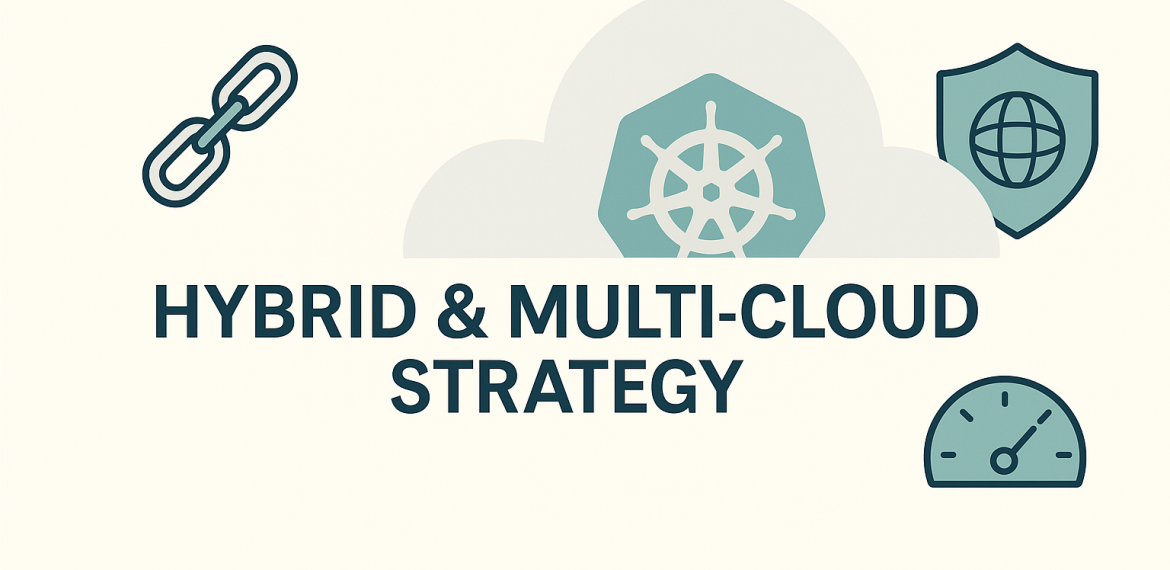
Hybrid & Multi‑cloud Strategy: Avoiding Lock‑In While Balancing Cost, Compliance, and Performance
Hybrid & Multi‑cloud Strategy: Avoiding Lock‑In While Balancing Cost, Compliance, and Performance
Enterprises are shifting from choosing a single cloud provider to embracing a mix of public and private environments. Hybrid and multi‑cloud strategies are not just technological trends – they are business imperatives. Organizations face increasing demands for agility, compliance, and innovation. These cannot be met by locking into a single vendor or environment. Instead, businesses are learning to build cloud strategies that are fluid, distributed, and resilient.
This transition isn’t just a matter of infrastructure. It requires a shift in mindset, governance, and tooling. With hybrid and multi‑cloud adoption comes greater flexibility, but also higher complexity. The challenge is to harness the benefits while managing cost, compliance, performance, and vendor dependence.
Understanding the hybrid and multi‑cloud landscape
A hybrid cloud combines on-premise infrastructure or private cloud with public cloud services. It allows data and applications to move between environments depending on needs. This architecture supports both agility and control.
Multi‑cloud, by contrast, refers to the use of multiple cloud providers. An enterprise might run analytics on Google Cloud, host services on AWS, and store backups in Azure. This spreads risk and enables teams to leverage best-in-class capabilities from each vendor.
In practice, most organizations end up using both models – combining hybrid connectivity with multi‑cloud flexibility. But doing so successfully requires a clear strategy.
Why avoiding vendor lock‑in is critical
At first, cloud vendor tools seem convenient. Using AWS Lambda, Google BigQuery, or Azure Cosmos DB speeds up development. But over time, these conveniences become constraints. Applications and data become tightly coupled to a specific vendor’s APIs, data formats, and billing practices.
Vendor lock‑in limits portability, drives up costs, and reduces flexibility. Businesses lose negotiating power, face expensive migration paths, and find themselves unable to respond quickly to regulatory or market changes. What begins as a tactical decision becomes a long-term liability.
Designing for portability and resilience
Avoiding lock‑in doesn’t mean avoiding all vendor services. It means designing systems in a way that minimizes coupling. One of the best strategies is to use open standards and cloud-agnostic technologies.
Containers and orchestration platforms like Kubernetes allow applications to be packaged in portable units that can run anywhere. Infrastructure-as-code tools such as Terraform help provision cloud resources consistently across different providers. Choosing open-source databases, messaging systems, and logging frameworks also supports long-term portability.
The architecture should make it possible – not necessarily easy, but possible – to move workloads between clouds when needed. This optionality becomes crucial in response to pricing shifts, outages, or geopolitical changes.
Balancing cost across clouds without losing control
Cloud costs can spiral quickly in multi‑cloud environments. Each provider has its own pricing model, hidden charges, and usage patterns. Managing cost requires more than billing dashboards. It demands cultural discipline, governance, and automation.
Organizations need full visibility into consumption patterns. FinOps practices – combining finance and DevOps – are becoming essential. Teams must budget at the project level, assign cost ownership, and optimize resource utilization continuously.
Intelligent workload placement is another strategy. If compute is cheaper on one cloud and storage is cheaper on another, applications should be able to span those environments. This requires data pipelines, security policies, and network design that can handle distributed operations.
Compliance in a fragmented regulatory world
Different industries and regions have different compliance requirements. A financial services company operating in Europe, Saudi Arabia, and the US must comply with GDPR, PDPL, and a host of local data residency laws. This becomes even more complex in a hybrid and multi‑cloud setup.
The key is to build compliance into the architecture. This includes selecting cloud regions that support local laws, applying encryption both at rest and in transit, and standardizing identity and access controls.
Policy-as-code frameworks allow compliance rules to be defined and enforced programmatically. For example, developers can be prevented from deploying workloads to non-compliant regions or using unapproved services. Auditing and logging must also be consistent across environments.
Compliance is not a one-time checklist. It is a continuous process that evolves as laws and threats evolve. Cloud strategy must keep up.
Managing performance across distributed architectures
When applications are distributed across clouds and on-premise environments, performance becomes unpredictable. Latency, throughput, and reliability all vary. Users may experience delays or failures if resources aren’t optimized.
To ensure performance, organizations must invest in observability. Monitoring tools like Datadog or Prometheus help collect metrics across clouds. Distributed tracing allows teams to pinpoint where delays are occurring.
Architectural decisions matter as well. Applications should be designed with locality in mind – keeping data close to compute and minimizing cross-cloud communication. In some cases, using dedicated interconnects between clouds or data centers improves performance significantly.
Load balancing, caching, and content delivery networks also play a role. These must be tuned not just for one provider, but for the entire system.
Creating a governance framework for hybrid and multi‑cloud success
Without governance, hybrid and multi‑cloud becomes chaos. Teams may deploy shadow IT, violate policies, or overspend without realizing it. A clear governance model aligns people, processes, and technology.
This model should define who owns what, how environments are provisioned, and how changes are approved. It should establish naming conventions, tagging strategies, access controls, and escalation paths.
Some enterprises create a Cloud Center of Excellence – a cross-functional team that sets standards and supports adoption. Others embed governance into platforms, using automation to enforce rules and provide guardrails.
The goal is not central control, but federated responsibility. Developers should have autonomy, but within a framework that ensures consistency, security, and efficiency.
The future of cloud strategy is coordination, not control
As hybrid and multi‑cloud adoption grows, enterprises must learn to think in terms of coordination. The goal is not to centralize everything, but to ensure all parts of the system can work together.
This requires investing in shared services – monitoring, security, identity, networking – that span clouds. It means choosing platforms and tools that speak the same language. It also means evolving skills, culture, and leadership.
Cloud strategy is no longer just an IT concern. It affects speed to market, customer experience, cost structure, and compliance risk. Executives must engage deeply and strategically.
How Buxton can help you build a winning hybrid and multi‑cloud strategy
Buxton brings deep expertise and hands-on experience in helping organizations navigate the complexities of hybrid and multi‑cloud environments. We understand that each enterprise has unique priorities – whether it’s modernizing legacy systems, meeting regional compliance mandates, or avoiding vendor lock‑in while controlling costs.
Our team works alongside your IT and business leaders to design cloud strategies that are resilient, scalable, and future-proof. From assessing your current infrastructure and identifying portability risks to implementing containerized workloads and automating governance, we help you build cloud-native foundations without sacrificing control.
We support our clients in:
Designing cloud-agnostic architectures that enable portability and prevent lock‑in
Implementing cost governance and optimization frameworks across cloud providers
Ensuring compliance with data residency and regulatory standards across regions including KSA, UAE, EU, and US
Enhancing application performance through workload placement, observability, and inter-cloud connectivity
Building federated governance models that balance freedom and control
With Buxton, you gain more than a technology partner – you gain a strategic advisor who understands the business impact of cloud decisions. Whether you are just starting your hybrid journey or scaling an existing multi‑cloud footprint, we help you do it with clarity, confidence, and measurable results.
Conclusion: mastering hybrid and multi‑cloud for competitive advantage
Hybrid and multi‑cloud strategies offer more than flexibility. They offer resilience, innovation, and alignment with complex business needs. But only when they are approached deliberately.
Avoiding lock‑in, managing costs, ensuring compliance, and maintaining performance are not separate tasks. They are interwoven goals that must be addressed together. A successful cloud strategy balances all of them.
The enterprises that master hybrid and multi‑cloud will not just keep up with change – they will shape it. They will adapt faster, serve customers better, and build more sustainable digital foundations for the future.

